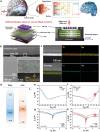Infrared-Triggered Retinomorphic Artificial Synapse Electronic Device Containing Multi-Dimensional van der Waals Heterojunctions
- PMID: 40033879
- PMCID: PMC12177863
- DOI: 10.1002/smll.202410892
Infrared-Triggered Retinomorphic Artificial Synapse Electronic Device Containing Multi-Dimensional van der Waals Heterojunctions
Abstract
Biological systems excel in image recognition with low power and fast responses. Inspired by the human eye, researchers have developed solid-state artificial visual systems. In this study, a retinomorphic artificial synapse device based on a tungsten diselenide (WSe2)/indium arsenide quantum dot (InAs QD) heterostructure is developed. This device exhibits enhanced short-wavelength infrared (SWIR) responsivity at 1060 nm, which is a synaptic behavior analogous to the human retina. The WSe2/InAs QD improves charge transport and photon absorption through the quantum confinement effects of InAs QDs, facilitating efficient SWIR detection. The heterojunction enables effective electron-hole pair separation, enhancing the photodetector performance. The device adapts to SWIR signal pulses like the human eye to light flicker. The WSe₂/InAs QD device demonstrates significantly higher responsivity and a superior ability to emulate a wide range of synaptic properties compared to previously reported Si-based and 2D material/QD-based devices. An artificial neural network trained on the Fashion MNIST dataset achieved over 85% accuracy, which is higher than previous reports. This showcases the potential of retina-inspired SWIR optoelectronic devices for compact, efficient machine vision and in-sensor computing. This study underscores the potential of integrating QDs with 2D materials to create advanced photodetectors that mimic biological sensory functions.
Keywords: 2D materials; artificial visual system; retinomorphic synapse device; short‐wavelength infrared; van der Waals heterojunction.
© 2025 The Author(s). Small published by Wiley‐VCH GmbH.
Conflict of interest statement
The authors declare no conflict of interest.
Figures






References
-
- Zrenner E., Science 2002, 295, 1022. - PubMed
-
- Li C., Du W., Huang Y., Zou J., Luo L., Sun S., Govorov A. O., Wu J., Xu H., Wang Z., Opto‐Electron. Adv. 2022, 5, 210069.
-
- Zhang J., Guo P., Guo Z., Li L., Sun T., Liu D., Tian L., Zu G., Xiong L., Zhang J., Huang J., Adv. Funct. Mater. 2023, 33, 2302885.
-
- Islam M. M., Krishnaprasad A., Dev D., Martinez‐Martinez R., Okonkwo V., Wu B., Han S. S., Bae T. S., Chung H. S., Touma J., Jung Y., Roy T., ACS Nano 2022, 16, 10188. - PubMed
-
- Zhang Z., Liu X., Zhou H., Xu S., Lee C., Small Struct. 2023, 5, 2300325.
LinkOut - more resources
Full Text Sources

